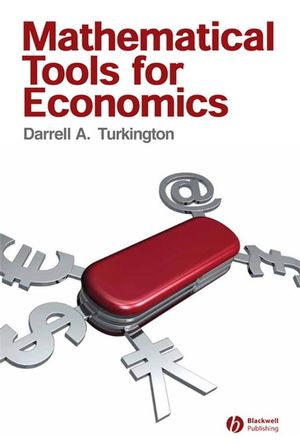|
Textbook
Mathematical Tools for EconomicsISBN: 978-1-4051-3380-7
Hardcover
380 pages
November 2006, ©2006, Wiley-Blackwell
 This is a Print-on-Demand title. It will be printed specifically to fill your order. Please allow an additional 10-15 days delivery time. The book is not returnable.
Other Available Formats: Paperback
|
||||||
Part I: Matrix Algebra and Linear Economic Models.
1. Matrix Algebra.
1.1 Basic Concepts.
1.2 Determinants.
1.3 The Inverse of a Matrix.
1.4 Linear Dependence of Vectors and the Rank of a Matrix.
1.5 Kronecker Products and Vecs of Matrices.
2. Simultaneous Linear Equations.
2.1 Definitions.
2.2 Homogeneous Case.
2.3 Nonhomogeneous Case.
2.4 Special Case m=n.
3. Linear Economic Models.
3.1 Introduction and Definitions.
3.2 Examples of Linear Economic Models.
3.3 The Use of Matrix Algebra in Statistics and Econometrics.
4. Quadratic Forms and Positive Definite Matrices.
4.1 Introduction.
4.2 Eigen Values of a Symmetric Matrix.
4.3 Eigen Values of Special Matrices.
4.4 Eigen Vectors of a Symmetric Matrix.
4.5 Matrix whose Columns are the Eigen Vectors of a Symmetric Matrix.
4.6 Diagonalization of Quadratic Forms.
4.7 Eigen Values , andAr (A), and trA.
4.8 An Alternative Approach using Determinants.
Part II: Functions of Many Variables and Optimization.
5. Functions of Many Variables.
5.1 Functions in General.
5.2 Partial Differentiation.
5.3 Special Sorts of Functions.
5.4 Comparative Statics and Nonlinear Economic Models.
5.5 Differentials and Taylor’s Approximation.
6. Optimization.
6.1 Unconstrained Optimization.
6.2 Local Optima and Global Optima.
6.3 Constrained Optimization.
6.4 Constrained Local Optima versus Constrained Global Optima.
6.5 An Introduction to Matrix Calculus.
7. Comparative Static Analysis in Optimization Problems.
7.1 Introduction.
7.2 Unconstrained Optimization.
7.3 Constrained Optimization.
7.4 Slutsky’s Equation.
7.5 Applications of the Envelope Theorems in Economics.
Part III: Dynamic Analysis.
8. Integration.
8.1 Introduction.
8.2 Definite Integrals.
8.3 Integration as Anti Differentiation.
8.4 Indefinite Integrals.
8.5 Further Considerations.
8.6 Economic Applications.
9. Continuous Time: Differential Equations.
9.1 Definitions.
9.2 Linear Differential Equations.
9.3 First Order Linear Differential Equations with Constant Coefficients.
9.4 Economic Dynamics Using First Order Differential Equations.
9.5 Second Order Linear Differential Equations with Constant Coefficents.
9.6 Economic Application: A Dynamic Supply and Demand Model.
9.7 Higher Order Linear Differential Equations.
9.8 Descriptive Analysis of Nonlinear Differential Equations.
10. Discrete Time: Difference Equations.
10.1 Introduction and Definitions.
10.2 First Order Linear Difference Equations with Constant Coefficients.
10.3 Second Order Linear Difference Equations with Constant Coefficients.
10.4 Investigating the Nature of the Roots of a Quadratic Equation.
10.5 Economic Applications.
10.6 Higher Order Linear Difference Equations.
11. Dynamic Optimization.
11.1 Introduction.
11.2 Dynamic Optimization versus Static Optimization.
11.3 The Basic Optimal Control Problem and Pontryagin’s Maximum Principle.
11.4 Extensions to the Basic Problem.
11.5 Economic Application: Ramsey/Solow Model.
Answers to exercises.
Further Reading.
Index.



